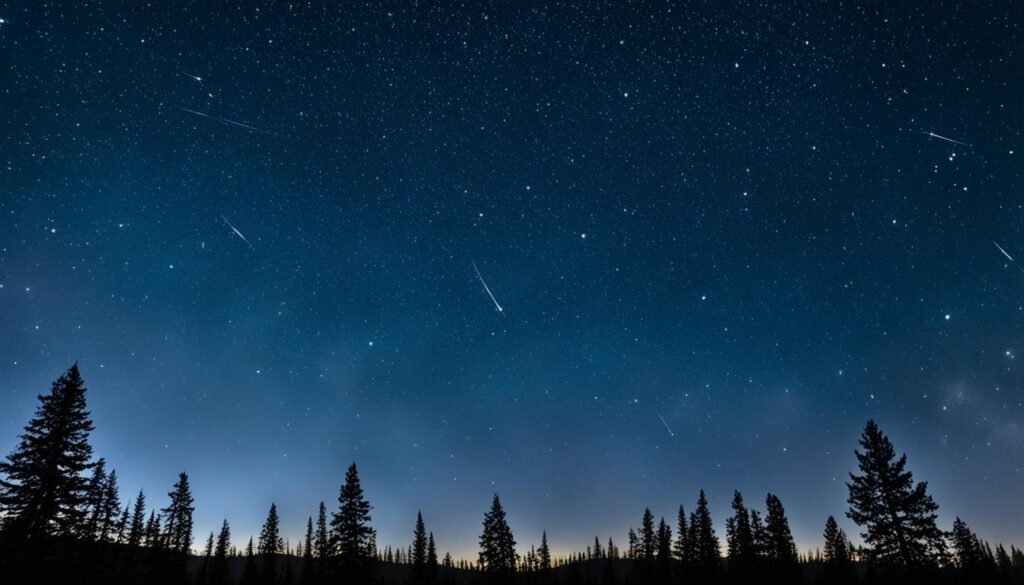As the Earth tilts towards the sun, bringing forth the rejuvenating spirit of spring, you may find yourself gazing upwards at the night sky, greeted by a captivating star pattern known as the Spring Triangle asterism. This celestial phenomenon is composed of three stellar beacons: Arcturus in Boötes, Spica in Virgo, and Regulus in Leo. Together, they form an astronomical triangle, a celestial signpost that ushers in warmer days ahead. Visible above the horizon before midnight as March concludes and prominently by mid-evening in early April, the Spring Triangle asterism has long been a herald of seasonal change. Whether you’re a seasoned stargazer or a casual observer, its presence never fails to inspire awe, capturing the essence of spring’s optimism and warmth.
Key Takeaways
- The Spring Triangle asterism marks the transition from winter to spring with its three bright stars.
- Each star – Arcturus, Spica, and Regulus – belongs to a different constellation, adding diversity to the celestial canvas.
- This asterism becomes entirely visible above the horizon before midnight in March and by mid-evening in April.
- Recognized by stargazers rather than the International Astronomical Union, it serves as an informal yet striking celestial guide.
- The narrow pyramid shape of the Spring Triangle makes it easily distinguishable from other star patterns in the sky.
- Its appearance carries cultural and historical significance, symbolizing the optimism of the forthcoming season.
Imagine the Heavens: Introduction to the Spring Triangle Asterism
As you gaze up at the night sky during the transition from the chilly winter to the blossoming spring, you may notice a trio of brilliant stars that form a beacon known as the Spring Triangle asterism. This celestial signpost is your guide to celestial navigation as well as a herald of seasonal change. The luminaries that create this pattern are the mighty stars Regulus of Leo, Arcturus of Boötes, and Spica of Virgo. Rising in succession—Regulus first, then Arcturus, and finally Spica—they announce the impending warmth and growth of spring.
The Spring Triangle’s clear visibility and the ease with which it can be found in the sky have made it a favorite among sky watchers and a vibrant illustration of the seasonal constellations. The individual brilliance of each star within the asterism enhances its usefulness for navigation and positions it firmly in the minds and hearts of those who seek connection with the cosmos. The emergence of these stars signifies an enduring relationship between celestial cycles and the earthly seasons, a rhythm as old as time itself.
Understanding the strategic placement and sequence of these stars is key to appreciating their role in springtime asterisms. Their alignment not only accompanies the equinox but also serves as a celestial clock, ticking away the last moments of the cold and the first moments of rebirth. This asterism does not merely exist for its beauty; it stands as a legacy of mankind’s journey through the ages, using the stars to chart a course and mark the passage of time.
- Regulus: The first to rise, marking the tail end of winter.
- Arcturus: Following Regulus, a red giant star leading us into change.
- Spica: The last to ascend, ushering in the full splendor of spring.
The Spring Triangle asterism beckons you to join in the celestial dance, tracing the paths of stars as our ancestors did. It’s an astronomical ritual that signifies the shedding of winters past and the embrace of a new season filled with possibilities and the beauty of the night sky.
Navigating the Stars: How to Locate the Celestial Triangle
For astrophiles and night sky enthusiasts, celestial navigation serves as an ancient GPS. With just a few stargazing tips, you can unravel the mystery of the skies above. This section will guide you on a journey to find the Spring Triangle using clear reference points and known patterns such as the Big Dipper, enhancing your sky watching experience.
Using the Big Dipper to Find the Spring Triangle
The Big Dipper, an iconic asterism itself, is your starting point. Imagine a dotted line extending upward from the Dipper’s handle—this is where you’ll “arc to Arcturus”. Then sweep your gaze from this bright star directly down to Spica. These two stars, with the addition of Regulus, form the vertices of the Spring Triangle.
Distinguishing the Spring Triangle from Other Seasonal Constellations
The celestial stage is crowded with patterns, each telling its own cosmic tale through the seasons. The Spring Triangle, though part of the larger narrative, stands out due to its distinct geometry compared to asterisms like the Winter Circle and Summer Triangle. Understanding its unique shape helps prevent confusion and leads to a gratifying stargazing journey.
Visual Guide to Identifying Arcturus, Spica, and Regulus
In sky watching, identifying major stars is critical. Arcturus shines brightest, Spica gleams with a bluish-white hue, and Regulus completes the Sickle’s pattern. With these three stars pinpointed, navigating the celestial sphere becomes almost second nature.

| Feature | Arcturus | Spica | Regulus |
|---|---|---|---|
| Color | Golden Orange | Bluish White | Pale Yellow |
| Brightness (Magnitude) | -0.05 | 1.04 | 1.35 |
| Constellation | Boötes | Virgo | Leo |
| Pattern | Isolated | Below Arcturus | Sickle |
The Luminous Corners of the Spring Triangle Asterism
In your stargazing adventures, you’ve likely marveled at the luminous corners of the Spring Triangle asterism, where Arcturus, Spica, and Regulus form a celestial phenomenon that has captivated observers for millennia. Each of these stellar beacons offers insight into the life cycle and characteristics of stars, from the swelling red giant to the interacting binary star, and finally to the regal heart of Leo. Let’s examine what makes these stars truly stand out in the night sky.
Arcturus: The Red Giant’s Glow
Arcturus is not just any star; it’s a red giant, a stellar behemoth that has ended the hydrogen-burning stage of its life. As the brightest star in the asterism, Arcturus sits merely 37 light-years from Earth, glowing with the luminous intensity that cuts through the vast emptiness of space. Its distinct orange hue is a telltale sign of its advanced age and the cooler surface temperature compared to our own Sun.
Spica: A Binary Star’s Blue-White Radiance
Spica, while appearing as a singular point of light to the naked eye, is in fact a binary star system—a cosmically bound pair of stars. Hidden within this single spark of blue-white radiance are two massive stars that whirl around each other, completing a cosmic dance every four days. This fascinating pair resides at a distance of 262 light-years away and exemplifies the dynamic interactions that binary stars can exhibit.
Regulus: The Heart of Leo
The quadruple star system of Regulus forms the base of the Sickle in Leo and shines as the heart of the famed constellation. At a closer look through a telescope, Regulus reveals a system where a predominant yellow supergiant star outshines its companions. Positioned approximately 79 light-years from our solar system, Regulus is a testament to the diverse celestial configurations that enrich our sky’s tapestry.
Each of these stars—Arcturus, Spica, and Regulus—offers a unique glimpse into the vast array of celestial phenomena present in our universe. Together, they create a night-time display that not only guides and delights stargazers but also serves as a living laboratory for astronomers unlocking the secrets of stellar evolution and galactic architecture.
Understanding the Distinction Between Asterisms and Constellations
As you delve into the wonders of the night sky, it’s essential to understand the differences between asterisms and constellations. While both may catch your attention as distinct celestial patterns, they are not one and the same when it comes to official classifications by the International Astronomical Union.
Asterisms are informal groups of stars, such as the Spring Triangle. They stand out due to their brightness and perceptible patterns, cutting across or nestling within official constellations. Constellations, on the other hand, hold a status that’s officially recognized, demarcating specific areas on the celestial sphere and serving a crucial role in celestial navigation.
To further elucidate the difference, consider the following distinctions:
- Asterisms: Informal patterns useful for quick identification and storytelling in the night sky.
- Constellations: Formally defined by the International Astronomical Union, mapping out the celestial sphere into 88 unique segments.
- Celestial Navigation: Both asterisms and constellations can guide observers, but constellations provide a more structured system for locating celestial bodies.
Asterisms like the Spring Triangle, while not officially recognized, play a significant role in astronomical culture and education. They help stargazers and astronomers alike to orient themselves and find other stars or celestial phenomena.
The Spring Triangle asterism may not be an official constellation, but its formation is among the most beloved celestial guides across multiple cultures, highlighting the social importance and widespread recognition of these stellar gatherings.

Recognizing these patterns not only enriches your understanding of the night sky but also connects you with centuries of human observation and the shared cultural legacy found in the stars.
Exploring the Depths: Deep Sky Objects in Proximity to the Spring Triangle
As you have traversed the celestial sphere unraveling the mysteries of the Spring Triangle, it’s now time to delve deeper into the cosmos. Far beyond the luminous guideposts of Arcturus, Spica, and Regulus lie fascinating deep sky objects that await your discovery. Imagine pointing your telescope a little further past these famous stars to unveil a spectacle of galactic wonder. Side by side with these beacons, the Virgo Cluster presents itself as a cosmic canvas sprawled across the night sky with over 1,500 galaxies, each with its own tale to tell within the universe’s grand tapestry.
As your celestial navigation skills grow, you’ll be privy to witnessing the enchanting dance of gravitational interaction within the Siamese Twins galaxies, or the piercing gaze of the Eyes Galaxies, watching over space-time’s continuum. The Leo Triplet—a trio of spiral galaxies entangled in a gravitational waltz—offers a visual feast of structure and order arising from cosmic chaos. The more you explore, the more the cosmos reveals, as the Boötes Dwarf Galaxy adds yet another layer to the depth of your sky-watching crusade.
Your journey through the stars is rich with possibilities, and each celestial landmark presents a new vantage point from which to survey the endless expanse. These galaxies and clusters comprise a universe teeming with activity, mystery, and beauty that far surpasses what the eye can behold. Engaging in celestial navigation around the Spring Triangle with these deep sky objects in mind, your stargazing experience transforms into an expedition, where each glance upward pulls back yet another veil on the universe’s infinite wonders.
FAQ
What is the Spring Triangle asterism?
The Spring Triangle asterism is an easily identifiable star pattern formed by three of the brightest stars from separate constellations: Arcturus in Boötes, Spica in Virgo, and Regulus in Leo. These stars form a triangular shape in the sky, acting as a celestial phenomenon that heralds the arrival of spring.
How does the Spring Triangle differ from an astronomical triangle?
While an astronomical triangle can refer to any trio of stars forming a triangle in the night sky, the Spring Triangle specifically refers to the particular asterism that consists of Arcturus, Spica, and Regulus. This formation is associated with the spring season due to its visibility during that time of the year.
What is the role of the Spring Triangle in celestial navigation?
The Spring Triangle serves as a guidepost for celestial navigation, helping observers to locate various seasonal constellations. The brightness and positioning of Arcturus, Spica, and Regulus make it easier to orient oneself while observing the night sky and to recognize other associated stellar formations.
How can you locate the Spring Triangle in the night sky?
To find the Spring Triangle, first identify the Big Dipper. Follow the arc of its handle to Arcturus and then extend the line down to Spica. To find Regulus, trace an imaginary line from the inner two stars of the Big Dipper’s bowl. This star-hopping method will help you spot the Spring Triangle asterism.
How is the Spring Triangle related to seasonal constellations?
The stars of the Spring Triangle belong to separate constellations that are best visible in the springtime night sky. This asterism is an integral part of the seasonal cycle of the constellations, marking a period when the daylight begins to extend and the weather warms up.
Can you explain the individual characteristics of Arcturus, Spica, and Regulus?
Arcturus is the brightest star in the Spring Triangle, an orange giant with an apparent magnitude of -0.05, located about 37 light-years away. Spica is a blue-white binary star system, 262 light-years from Earth, notable for its combined brightness and tight orbital period. Regulus is the heart of the constellation Leo, a quadruple star system approximately 79 light-years away, with a main yellow supergiant star. Each star contributes a unique brightness and color that enhance the asterism’s visibility.
What distinguishes an asterism from a constellation?
An asterism is an informal pattern of stars recognized by their apparent proximity and brightness in the night sky, often spanning across multiple constellations or residing within one. Constellations, in contrast, are officially defined areas of the celestial sphere with recognized boundaries, as designated by the International Astronomical Union.
What are some deep sky objects located near the Spring Triangle?
The region around the Spring Triangle boasts several deep sky objects to explore. These include the galaxies known as the Siamese Twins and the Eyes Galaxies, the Leo Triplet, and the Boötes Dwarf Galaxy. Additionally, the Virgo Cluster contains around 1,500 galaxies, making it an extensive field for celestial observation and an exciting destination for stargazers.






